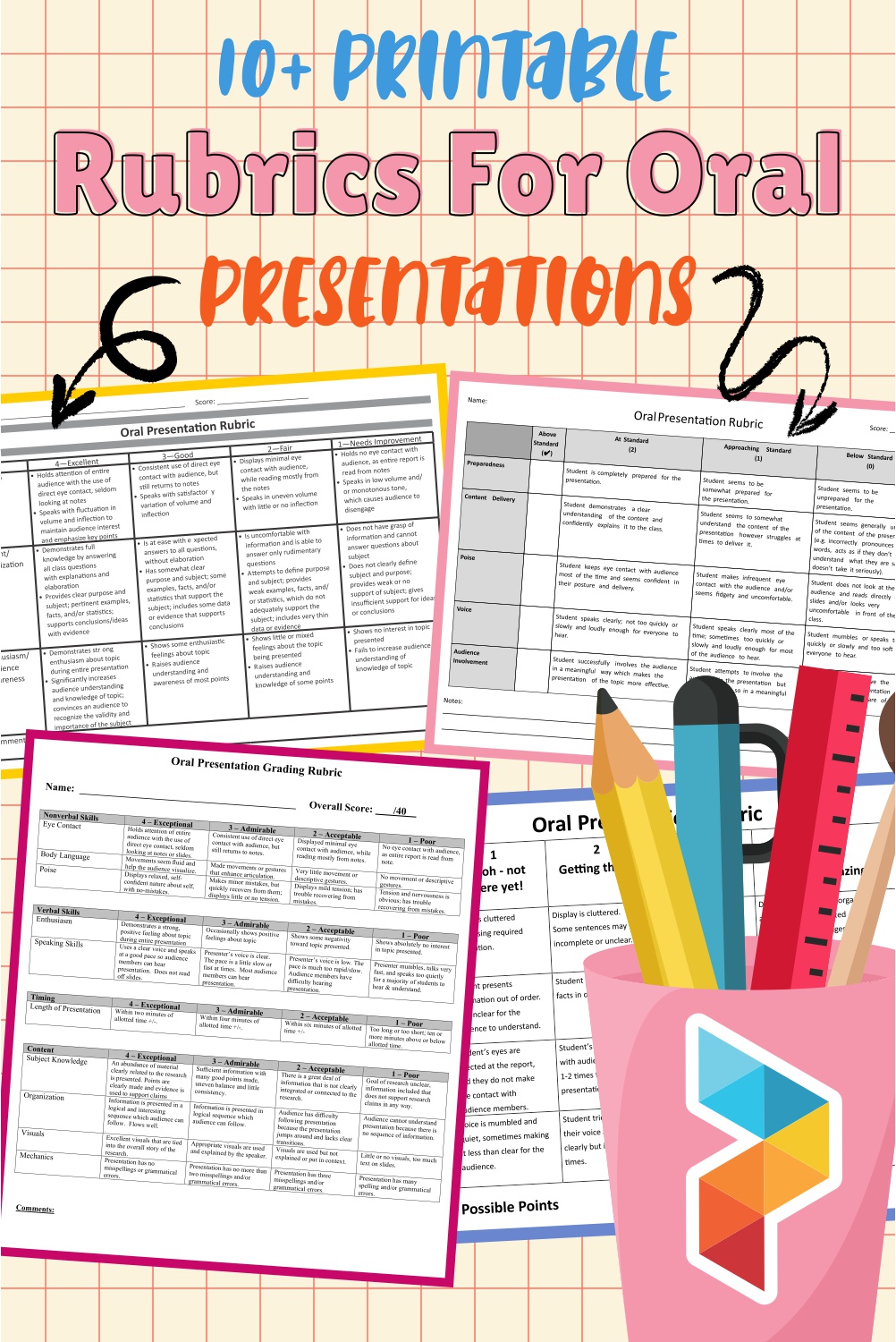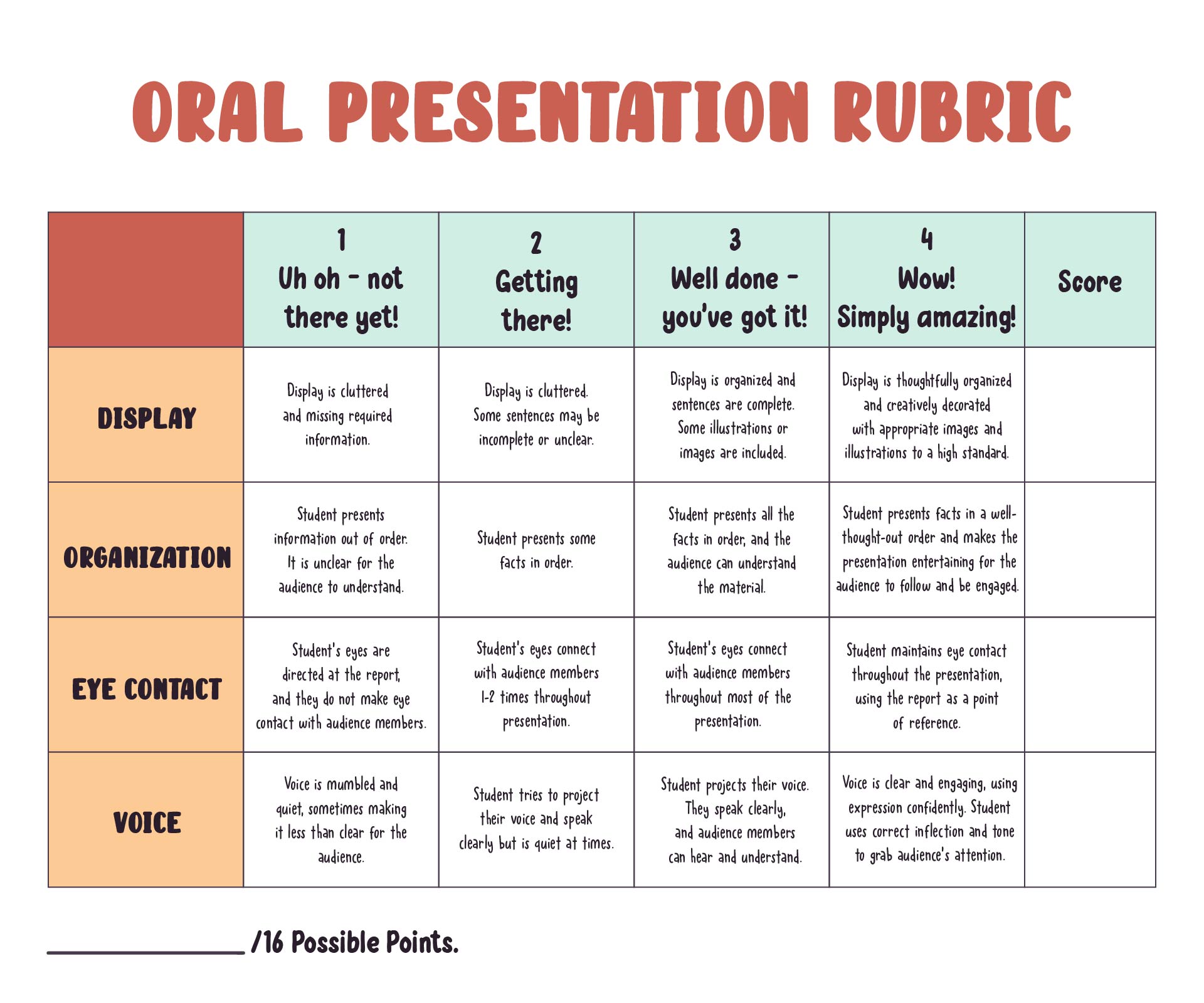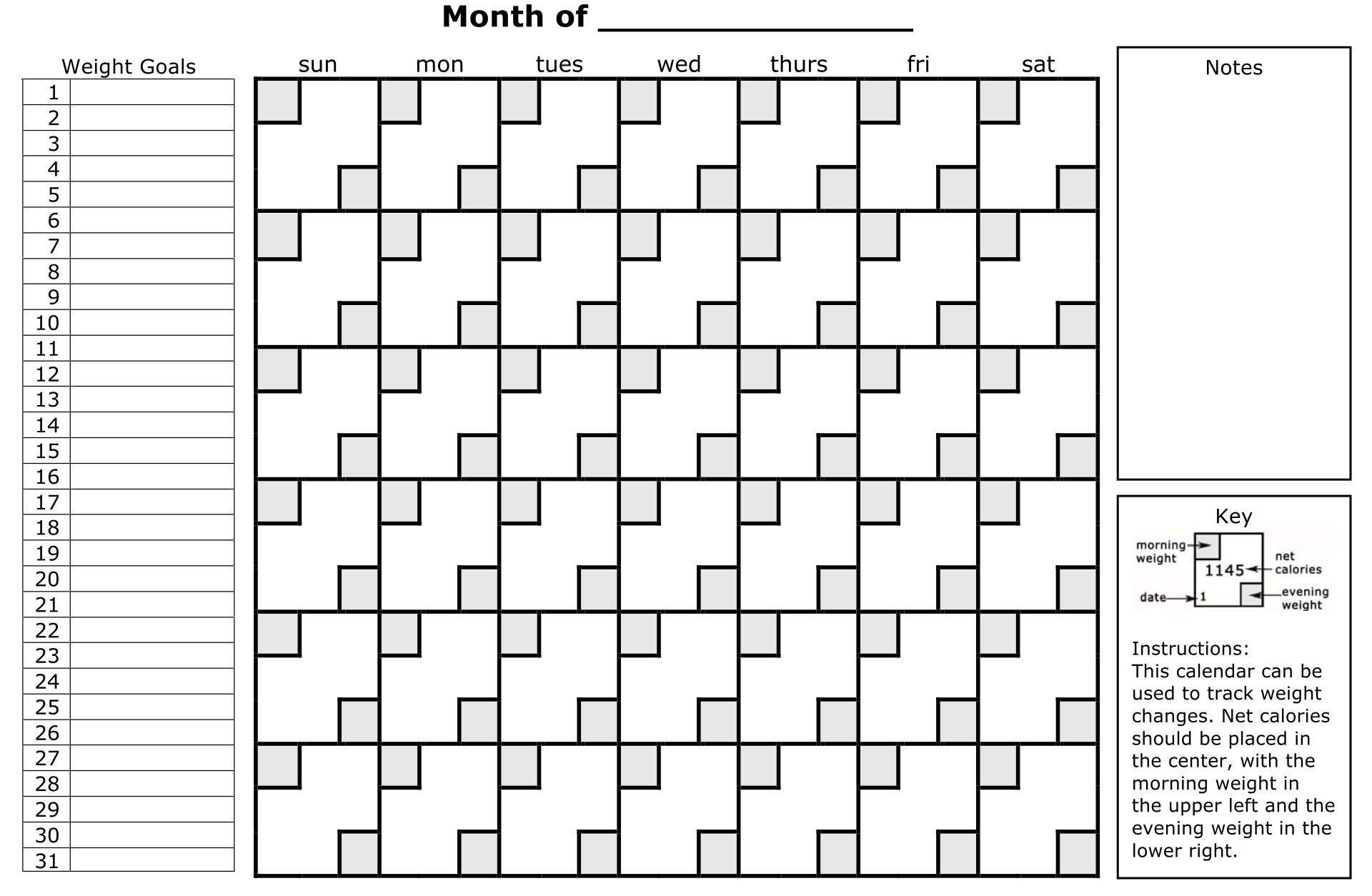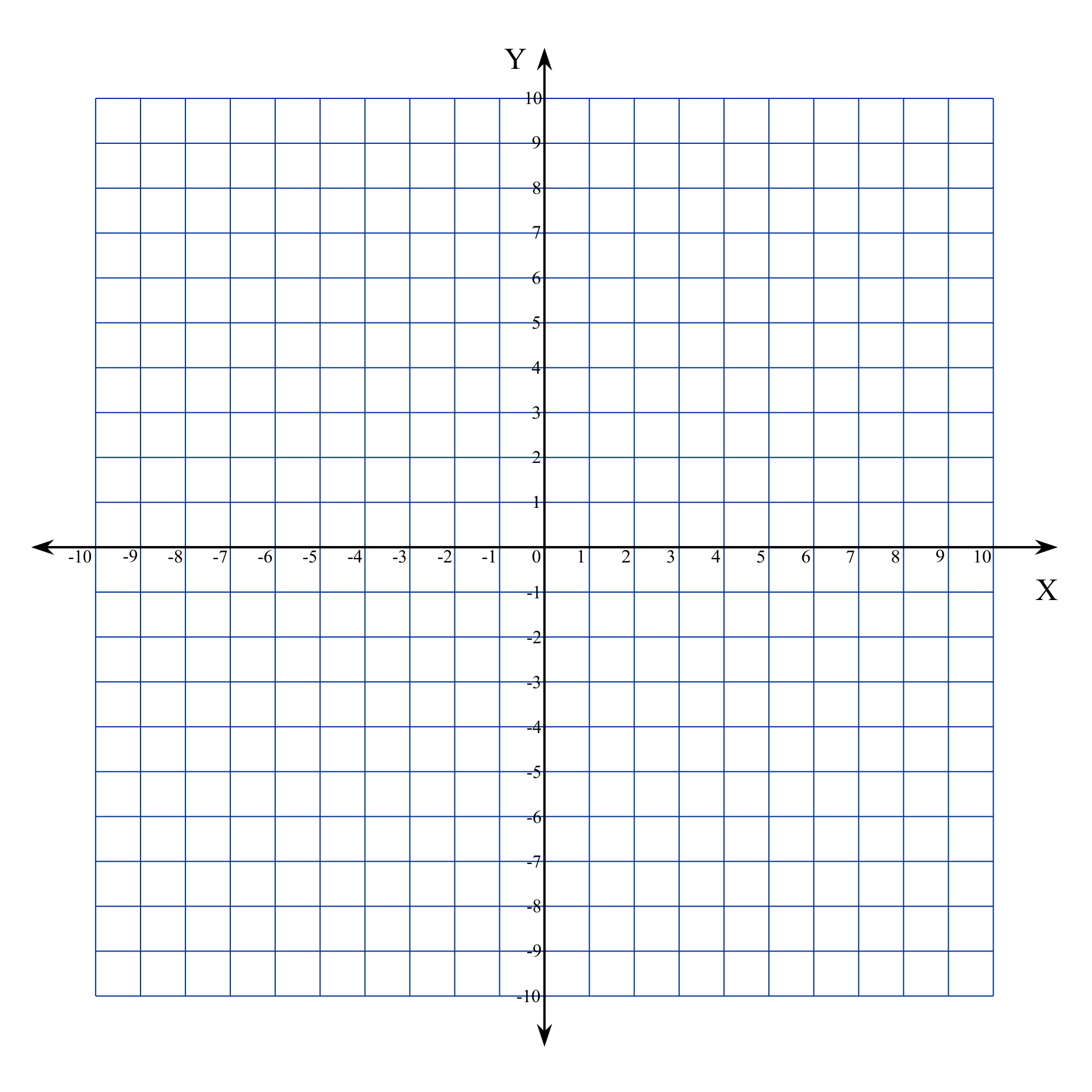Rubrics for Oral Presentations
Introduction.
Many instructors require students to give oral presentations, which they evaluate and count in students’ grades. It is important that instructors clarify their goals for these presentations as well as the student learning objectives to which they are related. Embedding the assignment in course goals and learning objectives allows instructors to be clear with students about their expectations and to develop a rubric for evaluating the presentations.
A rubric is a scoring guide that articulates and assesses specific components and expectations for an assignment. Rubrics identify the various criteria relevant to an assignment and then explicitly state the possible levels of achievement along a continuum, so that an effective rubric accurately reflects the expectations of an assignment. Using a rubric to evaluate student performance has advantages for both instructors and students. Creating Rubrics
Rubrics can be either analytic or holistic. An analytic rubric comprises a set of specific criteria, with each one evaluated separately and receiving a separate score. The template resembles a grid with the criteria listed in the left column and levels of performance listed across the top row, using numbers and/or descriptors. The cells within the center of the rubric contain descriptions of what expected performance looks like for each level of performance.
A holistic rubric consists of a set of descriptors that generate a single, global score for the entire work. The single score is based on raters’ overall perception of the quality of the performance. Often, sentence- or paragraph-length descriptions of different levels of competencies are provided.
When applied to an oral presentation, rubrics should reflect the elements of the presentation that will be evaluated as well as their relative importance. Thus, the instructor must decide whether to include dimensions relevant to both form and content and, if so, which one. Additionally, the instructor must decide how to weight each of the dimensions – are they all equally important, or are some more important than others? Additionally, if the presentation represents a group project, the instructor must decide how to balance grading individual and group contributions. Evaluating Group Projects
Creating Rubrics
The steps for creating an analytic rubric include the following:
1. Clarify the purpose of the assignment. What learning objectives are associated with the assignment?
2. Look for existing rubrics that can be adopted or adapted for the specific assignment
3. Define the criteria to be evaluated
4. Choose the rating scale to measure levels of performance
5. Write descriptions for each criterion for each performance level of the rating scale
6. Test and revise the rubric
Examples of criteria that have been included in rubrics for evaluation oral presentations include:
- Knowledge of content
- Organization of content
- Presentation of ideas
- Research/sources
- Visual aids/handouts
- Language clarity
- Grammatical correctness
- Time management
- Volume of speech
- Rate/pacing of Speech
- Mannerisms/gestures
- Eye contact/audience engagement
Examples of scales/ratings that have been used to rate student performance include:
- Strong, Satisfactory, Weak
- Beginning, Intermediate, High
- Exemplary, Competent, Developing
- Excellent, Competent, Needs Work
- Exceeds Standard, Meets Standard, Approaching Standard, Below Standard
- Exemplary, Proficient, Developing, Novice
- Excellent, Good, Marginal, Unacceptable
- Advanced, Intermediate High, Intermediate, Developing
- Exceptional, Above Average, Sufficient, Minimal, Poor
- Master, Distinguished, Proficient, Intermediate, Novice
- Excellent, Good, Satisfactory, Poor, Unacceptable
- Always, Often, Sometimes, Rarely, Never
- Exemplary, Accomplished, Acceptable, Minimally Acceptable, Emerging, Unacceptable
Grading and Performance Rubrics Carnegie Mellon University Eberly Center for Teaching Excellence & Educational Innovation
Creating and Using Rubrics Carnegie Mellon University Eberly Center for Teaching Excellence & Educational Innovation
Using Rubrics Cornell University Center for Teaching Innovation
Rubrics DePaul University Teaching Commons
Building a Rubric University of Texas/Austin Faculty Innovation Center
Building a Rubric Columbia University Center for Teaching and Learning
Rubric Development University of West Florida Center for University Teaching, Learning, and Assessment
Creating and Using Rubrics Yale University Poorvu Center for Teaching and Learning
Designing Grading Rubrics Brown University Sheridan Center for Teaching and Learning

Examples of Oral Presentation Rubrics
Oral Presentation Rubric Pomona College Teaching and Learning Center
Oral Presentation Evaluation Rubric University of Michigan
Oral Presentation Rubric Roanoke College
Oral Presentation: Scoring Guide Fresno State University Office of Institutional Effectiveness
Presentation Skills Rubric State University of New York/New Paltz School of Business
Oral Presentation Rubric Oregon State University Center for Teaching and Learning
Oral Presentation Rubric Purdue University College of Science
Group Class Presentation Sample Rubric Pepperdine University Graziadio Business School
Rubric Best Practices, Examples, and Templates
A rubric is a scoring tool that identifies the different criteria relevant to an assignment, assessment, or learning outcome and states the possible levels of achievement in a specific, clear, and objective way. Use rubrics to assess project-based student work including essays, group projects, creative endeavors, and oral presentations.
Rubrics can help instructors communicate expectations to students and assess student work fairly, consistently and efficiently. Rubrics can provide students with informative feedback on their strengths and weaknesses so that they can reflect on their performance and work on areas that need improvement.
How to Get Started
Best practices, moodle how-to guides.
- Workshop Recording (Fall 2022)
- Workshop Registration
Step 1: Analyze the assignment
The first step in the rubric creation process is to analyze the assignment or assessment for which you are creating a rubric. To do this, consider the following questions:
- What is the purpose of the assignment and your feedback? What do you want students to demonstrate through the completion of this assignment (i.e. what are the learning objectives measured by it)? Is it a summative assessment, or will students use the feedback to create an improved product?
- Does the assignment break down into different or smaller tasks? Are these tasks equally important as the main assignment?
- What would an “excellent” assignment look like? An “acceptable” assignment? One that still needs major work?
- How detailed do you want the feedback you give students to be? Do you want/need to give them a grade?
Step 2: Decide what kind of rubric you will use
Types of rubrics: holistic, analytic/descriptive, single-point
Holistic Rubric. A holistic rubric includes all the criteria (such as clarity, organization, mechanics, etc.) to be considered together and included in a single evaluation. With a holistic rubric, the rater or grader assigns a single score based on an overall judgment of the student’s work, using descriptions of each performance level to assign the score.
Advantages of holistic rubrics:
- Can p lace an emphasis on what learners can demonstrate rather than what they cannot
- Save grader time by minimizing the number of evaluations to be made for each student
- Can be used consistently across raters, provided they have all been trained
Disadvantages of holistic rubrics:
- Provide less specific feedback than analytic/descriptive rubrics
- Can be difficult to choose a score when a student’s work is at varying levels across the criteria
- Any weighting of c riteria cannot be indicated in the rubric
Analytic/Descriptive Rubric . An analytic or descriptive rubric often takes the form of a table with the criteria listed in the left column and with levels of performance listed across the top row. Each cell contains a description of what the specified criterion looks like at a given level of performance. Each of the criteria is scored individually.
Advantages of analytic rubrics:
- Provide detailed feedback on areas of strength or weakness
- Each criterion can be weighted to reflect its relative importance
Disadvantages of analytic rubrics:
- More time-consuming to create and use than a holistic rubric
- May not be used consistently across raters unless the cells are well defined
- May result in giving less personalized feedback
Single-Point Rubric . A single-point rubric is breaks down the components of an assignment into different criteria, but instead of describing different levels of performance, only the “proficient” level is described. Feedback space is provided for instructors to give individualized comments to help students improve and/or show where they excelled beyond the proficiency descriptors.
Advantages of single-point rubrics:
- Easier to create than an analytic/descriptive rubric
- Perhaps more likely that students will read the descriptors
- Areas of concern and excellence are open-ended
- May removes a focus on the grade/points
- May increase student creativity in project-based assignments
Disadvantage of analytic rubrics: Requires more work for instructors writing feedback
Step 3 (Optional): Look for templates and examples.
You might Google, “Rubric for persuasive essay at the college level” and see if there are any publicly available examples to start from. Ask your colleagues if they have used a rubric for a similar assignment. Some examples are also available at the end of this article. These rubrics can be a great starting point for you, but consider steps 3, 4, and 5 below to ensure that the rubric matches your assignment description, learning objectives and expectations.
Step 4: Define the assignment criteria
Make a list of the knowledge and skills are you measuring with the assignment/assessment Refer to your stated learning objectives, the assignment instructions, past examples of student work, etc. for help.
Helpful strategies for defining grading criteria:
- Collaborate with co-instructors, teaching assistants, and other colleagues
- Brainstorm and discuss with students
- Can they be observed and measured?
- Are they important and essential?
- Are they distinct from other criteria?
- Are they phrased in precise, unambiguous language?
- Revise the criteria as needed
- Consider whether some are more important than others, and how you will weight them.
Step 5: Design the rating scale
Most ratings scales include between 3 and 5 levels. Consider the following questions when designing your rating scale:
- Given what students are able to demonstrate in this assignment/assessment, what are the possible levels of achievement?
- How many levels would you like to include (more levels means more detailed descriptions)
- Will you use numbers and/or descriptive labels for each level of performance? (for example 5, 4, 3, 2, 1 and/or Exceeds expectations, Accomplished, Proficient, Developing, Beginning, etc.)
- Don’t use too many columns, and recognize that some criteria can have more columns that others . The rubric needs to be comprehensible and organized. Pick the right amount of columns so that the criteria flow logically and naturally across levels.
Step 6: Write descriptions for each level of the rating scale
Artificial Intelligence tools like Chat GPT have proven to be useful tools for creating a rubric. You will want to engineer your prompt that you provide the AI assistant to ensure you get what you want. For example, you might provide the assignment description, the criteria you feel are important, and the number of levels of performance you want in your prompt. Use the results as a starting point, and adjust the descriptions as needed.
Building a rubric from scratch
For a single-point rubric , describe what would be considered “proficient,” i.e. B-level work, and provide that description. You might also include suggestions for students outside of the actual rubric about how they might surpass proficient-level work.
For analytic and holistic rubrics , c reate statements of expected performance at each level of the rubric.
- Consider what descriptor is appropriate for each criteria, e.g., presence vs absence, complete vs incomplete, many vs none, major vs minor, consistent vs inconsistent, always vs never. If you have an indicator described in one level, it will need to be described in each level.
- You might start with the top/exemplary level. What does it look like when a student has achieved excellence for each/every criterion? Then, look at the “bottom” level. What does it look like when a student has not achieved the learning goals in any way? Then, complete the in-between levels.
- For an analytic rubric , do this for each particular criterion of the rubric so that every cell in the table is filled. These descriptions help students understand your expectations and their performance in regard to those expectations.
Well-written descriptions:
- Describe observable and measurable behavior
- Use parallel language across the scale
- Indicate the degree to which the standards are met
Step 7: Create your rubric
Create your rubric in a table or spreadsheet in Word, Google Docs, Sheets, etc., and then transfer it by typing it into Moodle. You can also use online tools to create the rubric, but you will still have to type the criteria, indicators, levels, etc., into Moodle. Rubric creators: Rubistar , iRubric
Step 8: Pilot-test your rubric
Prior to implementing your rubric on a live course, obtain feedback from:
- Teacher assistants
Try out your new rubric on a sample of student work. After you pilot-test your rubric, analyze the results to consider its effectiveness and revise accordingly.
- Limit the rubric to a single page for reading and grading ease
- Use parallel language . Use similar language and syntax/wording from column to column. Make sure that the rubric can be easily read from left to right or vice versa.
- Use student-friendly language . Make sure the language is learning-level appropriate. If you use academic language or concepts, you will need to teach those concepts.
- Share and discuss the rubric with your students . Students should understand that the rubric is there to help them learn, reflect, and self-assess. If students use a rubric, they will understand the expectations and their relevance to learning.
- Consider scalability and reusability of rubrics. Create rubric templates that you can alter as needed for multiple assignments.
- Maximize the descriptiveness of your language. Avoid words like “good” and “excellent.” For example, instead of saying, “uses excellent sources,” you might describe what makes a resource excellent so that students will know. You might also consider reducing the reliance on quantity, such as a number of allowable misspelled words. Focus instead, for example, on how distracting any spelling errors are.
Example of an analytic rubric for a final paper
Example of a holistic rubric for a final paper, single-point rubric, more examples:.
- Single Point Rubric Template ( variation )
- Analytic Rubric Template make a copy to edit
- A Rubric for Rubrics
- Bank of Online Discussion Rubrics in different formats
- Mathematical Presentations Descriptive Rubric
- Math Proof Assessment Rubric
- Kansas State Sample Rubrics
- Design Single Point Rubric
Technology Tools: Rubrics in Moodle
- Moodle Docs: Rubrics
- Moodle Docs: Grading Guide (use for single-point rubrics)
Tools with rubrics (other than Moodle)
- Google Assignments
- Turnitin Assignments: Rubric or Grading Form
Other resources
- DePaul University (n.d.). Rubrics .
- Gonzalez, J. (2014). Know your terms: Holistic, Analytic, and Single-Point Rubrics . Cult of Pedagogy.
- Goodrich, H. (1996). Understanding rubrics . Teaching for Authentic Student Performance, 54 (4), 14-17. Retrieved from
- Miller, A. (2012). Tame the beast: tips for designing and using rubrics.
- Ragupathi, K., Lee, A. (2020). Beyond Fairness and Consistency in Grading: The Role of Rubrics in Higher Education. In: Sanger, C., Gleason, N. (eds) Diversity and Inclusion in Global Higher Education. Palgrave Macmillan, Singapore.

Eberly Center
Teaching excellence & educational innovation, creating and using rubrics.
A rubric is a scoring tool that explicitly describes the instructor’s performance expectations for an assignment or piece of work. A rubric identifies:
- criteria: the aspects of performance (e.g., argument, evidence, clarity) that will be assessed
- descriptors: the characteristics associated with each dimension (e.g., argument is demonstrable and original, evidence is diverse and compelling)
- performance levels: a rating scale that identifies students’ level of mastery within each criterion
Rubrics can be used to provide feedback to students on diverse types of assignments, from papers, projects, and oral presentations to artistic performances and group projects.
Benefitting from Rubrics
- reduce the time spent grading by allowing instructors to refer to a substantive description without writing long comments
- help instructors more clearly identify strengths and weaknesses across an entire class and adjust their instruction appropriately
- help to ensure consistency across time and across graders
- reduce the uncertainty which can accompany grading
- discourage complaints about grades
- understand instructors’ expectations and standards
- use instructor feedback to improve their performance
- monitor and assess their progress as they work towards clearly indicated goals
- recognize their strengths and weaknesses and direct their efforts accordingly
Examples of Rubrics
Here we are providing a sample set of rubrics designed by faculty at Carnegie Mellon and other institutions. Although your particular field of study or type of assessment may not be represented, viewing a rubric that is designed for a similar assessment may give you ideas for the kinds of criteria, descriptions, and performance levels you use on your own rubric.
- Example 1: Philosophy Paper This rubric was designed for student papers in a range of courses in philosophy (Carnegie Mellon).
- Example 2: Psychology Assignment Short, concept application homework assignment in cognitive psychology (Carnegie Mellon).
- Example 3: Anthropology Writing Assignments This rubric was designed for a series of short writing assignments in anthropology (Carnegie Mellon).
- Example 4: History Research Paper . This rubric was designed for essays and research papers in history (Carnegie Mellon).
- Example 1: Capstone Project in Design This rubric describes the components and standards of performance from the research phase to the final presentation for a senior capstone project in design (Carnegie Mellon).
- Example 2: Engineering Design Project This rubric describes performance standards for three aspects of a team project: research and design, communication, and team work.
Oral Presentations
- Example 1: Oral Exam This rubric describes a set of components and standards for assessing performance on an oral exam in an upper-division course in history (Carnegie Mellon).
- Example 2: Oral Communication This rubric is adapted from Huba and Freed, 2000.
- Example 3: Group Presentations This rubric describes a set of components and standards for assessing group presentations in history (Carnegie Mellon).
Class Participation/Contributions
- Example 1: Discussion Class This rubric assesses the quality of student contributions to class discussions. This is appropriate for an undergraduate-level course (Carnegie Mellon).
- Example 2: Advanced Seminar This rubric is designed for assessing discussion performance in an advanced undergraduate or graduate seminar.
See also " Examples and Tools " section of this site for more rubrics.
CONTACT US to talk with an Eberly colleague in person!
- Faculty Support
- Graduate Student Support
- Canvas @ Carnegie Mellon
- Quick Links

Rubrics For Oral Presentations
Printable rubrics for oral presentations provide a straightforward tool for evaluating the effectiveness and quality of students' speeches or presentations.
They offer clear criteria, such as organization, content understanding, delivery, and audience engagement, making it easier for you to assess performances consistently and objectively. By using these rubrics, you can give valuable feedback to your students, helping them identify their strengths and areas for improvement, which can significantly enhance their future presentation skills.

Table of Images 👆
Oral presentation grading rubric, oral presentation rubric high school.
- Oral Presentation Rubric
Oral Presentation Rubric Elementary
- Rubric For Oral Presentation High School
- Rubrics For Oral Presentations In College
- Analytic Rubrics For Oral Presentation
- Kid Friendly Oral Presentation Rubric

A high school oral presentation rubric is an essential tool that can guide you in preparing and delivering effective presentations. It outlines clear expectations regarding content, organization, delivery, and visual aids, ensuring your presentation is both engaging and informative. By following this rubric, you can enhance your public speaking skills, making a lasting impression on your audience and achieving a higher grade.
The oral presentation grading rubric serves as a fair and standardized method for teachers to assess your speaking abilities and presentation skills. It evaluates critical aspects such as clarity, coherence, pronunciation, and audience engagement. Familiarizing yourself with the grading criteria can help you identify areas for improvement, tailoring your performance to meet or exceed expectations.
An oral presentation rubric for elementary students is designed to encourage young learners to practice and develop their public speaking skills in a structured way. It focuses on basic presentation elements like articulation, confidence, and topic understanding. Using this rubric, you can gain valuable feedback on your performance, helping you become a more effective communicator from an early age.
More printable images tagged with:
Have something to tell us?
Recent Comments

Nov 22, 2022
I really appreciate the availability of these printable rubrics for oral presentations! They have been a great tool to help me evaluate and improve my presentation skills. Thank you for providing this helpful resource!
Sep 11, 2022
I love using these printable rubrics for oral presentations! They provide clear guidelines and help me evaluate my students' communication skills effectively. Thank you for making it easier for me to assess their progress!
Aug 28, 2022
Printable rubrics for oral presentations are valuable tools for both teachers and students, as they provide clear guidelines and criteria for assessing and improving presentation skills, fostering learning and professional growth.

Find Hidden Objects Puzzles

Hard Find The

Weight Loss Program

Pumpkin Dot Marker Page

Coordinate Grids
Miniature World Flags Downloadable
Find free printable content.

IMAGES
VIDEO
COMMENTS
Oral Presentation Rubric 4—Excellent 3—Good 2—Fair 1—Needs Improvement Delivery • Holds attention of entire audience with the use of direct eye contact, seldom looking at notes • Speaks with fluctuation in volume and inflection to maintain audience interest and emphasize key points • Consistent use of direct eye contact with ...
Oral Presentation Rubric : Sample Rubric - Oral Presentation CATEGORY 4 3 2 1 Content Shows a good Shows a full understanding of the topic. Shows a good understanding of the topic. understanding of parts of the topic. Does not seem to understand the topic very well. Volume Volume is loud enough to be heard by all audience members throughout the
The rubric allows teachers to assess students in several key areas of oral presentation. Students are scored on a scale of 1-4 in three major areas. The first area is Delivery, which includes eye contact, and voice inflection. The second area, Content/Organization, scores students based on their knowledge and understanding of the topic being ...
Oral Presentation Evaluation Rubric, Formal Setting . PRESENTER: Non-verbal skills (Poise) 5 4 3 2 1 Comfort Relaxed, easy presentation with minimal hesitation Generally comfortable appearance, occasional hesitation Somewhat comfortable appearance, some hesitation Generally uncomfortable, difficulty with flow of presentation Completely
overly text-heavy, distracting, unconnected to claim, or otherwise claim, or otherwise presentation. ineffective. connected to claim, and effectively help support. Speech and manner (eye contact, volume, clarity, pacing) Speech and manner One or more are not effective: pacing may be too fast or slow; eye contact may not be present; voice may be ...
This rubric is specifically designed to evaluate the oral presentations of a single speaker at a time and is best applied to live or video-recorded presentations. It is recommended that each speaker be evaluated separately for panel or group presentations. This rubric best applies to presentations of sufficient length such that a central ...
A rubric is a scoring guide that articulates and assesses specific components and expectations for an oral presentation. Learn how to create and use an analytic or holistic rubric, and see examples of criteria and scales for oral presentations. Find sample rubrics from various sources and disciplines.
Oral Presentation Rubric. No movement or descriptive gestures. Very little movement or descriptive gestures. Movements or gestures enhance articulation. Movements seemed fluid and helped the audience visualize. No eye contact with audience. Minimal eye contact with audience. Consistent use of direct eye. contact with some audience.
This rubric is designed to help you evaluate the organization, design, and delivery of standard research talks and other oral presentations. Here are some ways to use it: Distribute the rubric to colleagues before a dress rehearsal of your talk. Use the rubric to collect feedback and improve your presentation and delivery.
Create a second list to the side of the board, called "Let it slide," asking students what, as a class, they should "let slide" in the oral presentations. Guide and elaborate, choosing whether to reject, accept, or compromise on the students' proposals. Distribute the two lists to students as-is as a checklist-style rubric or flesh ...
Oral Presentation Rubric. Holds attention of entire audience with the use of direct eye contact, seldom looking at notes. Consistent use of direct eye contact with audience, but still returns to notes. Displayed minimal eye contact with audience, while reading mostly from the notes. No eye contact with audience, as entire report is read from notes.
Step 7: Create your rubric. Create your rubric in a table or spreadsheet in Word, Google Docs, Sheets, etc., and then transfer it by typing it into Moodle. You can also use online tools to create the rubric, but you will still have to type the criteria, indicators, levels, etc., into Moodle.
An oral presentation allows the student to demonstrate content knowledge by presenting the findings of an inquiry to an audience. The audience may include students in the class and other classes, parents and relatives, and community members. Presenting allows the student to explain the methods that were used, to report the results of the ...
Oral Presentations. Example 1: Oral Exam This rubric describes a set of components and standards for assessing performance on an oral exam in an upper-division course in history (Carnegie Mellon). Example 2: Oral Communication This rubric is adapted from Huba and Freed, 2000.
Oral Presentation Grading Rubric Name: _____ Overall Score: /40 Nonverbal Skills 4 - Exceptional 3 - Admirable 2 - Acceptable 1 - Poor Eye Contact Holds attention of entire audience with the use of direct eye contact, seldom looking at notes or slides. Consistent use of direct eye
How to Use a Rubric. This lesson offers a sample oral presentation rubric. The categories to be graded are: information, presentation, and visual aids. You will note that each of these categories ...
Title: Scoring Rubric for Oral Presentations: Example #1 Author: Testing and Evaluation Services Created Date: 8/10/2017 9:45:03 AM
Sample Analytic Rubric: Oral Presentation Excellent Adequate Limited Poor Content The speech d emonstrates thorough and accurate knowledge of the subject matter. The speech demonstrates accurate knowledge except in minor details. The speech demonstrates some knowledge of the topic, but there are inaccuracies in important details
Group Oral Presentation Rubric. All group members participate equally. All group members participate. Some group members participate. Only 1 or 2 group members participate. Group members help each other as needed. Group members help each other as needed. Some group members speak clearly and are easy to understand.
The goal of this rubric is to identify and assess elements of research presentations, including delivery strategies and slide design. • Self-assessment: Record yourself presenting your talk using your computer's pre-downloaded recording software or by using the coach in Microsoft PowerPoint. Then review your recording, fill in the rubric ...
Keywords Digital rubrics · Analytic rubrics · Video-enhanced rubrics · Oral presentation skills · Formative assessment method * Rob J. Nadolski [email protected] Extended author information available on the last page of the article. 2664 R. J. Nadolski et al. 1 3 Introduction
RubiStar is a tool to help the teacher who wants to use rubrics, but does not have the time to develop them from scratch. ... Oral Presentation Rubric : Sample Rubric - Oral Presentation. CATEGORY 4 3 2 1 Content Shows a full understanding of the topic. Shows a good understanding of the topic. ...
An oral presentation rubric for elementary students is designed to encourage young learners to practice and develop their public speaking skills in a structured way. It focuses on basic presentation elements like articulation, confidence, and topic understanding. Using this rubric, you can gain valuable feedback on your performance, helping you ...